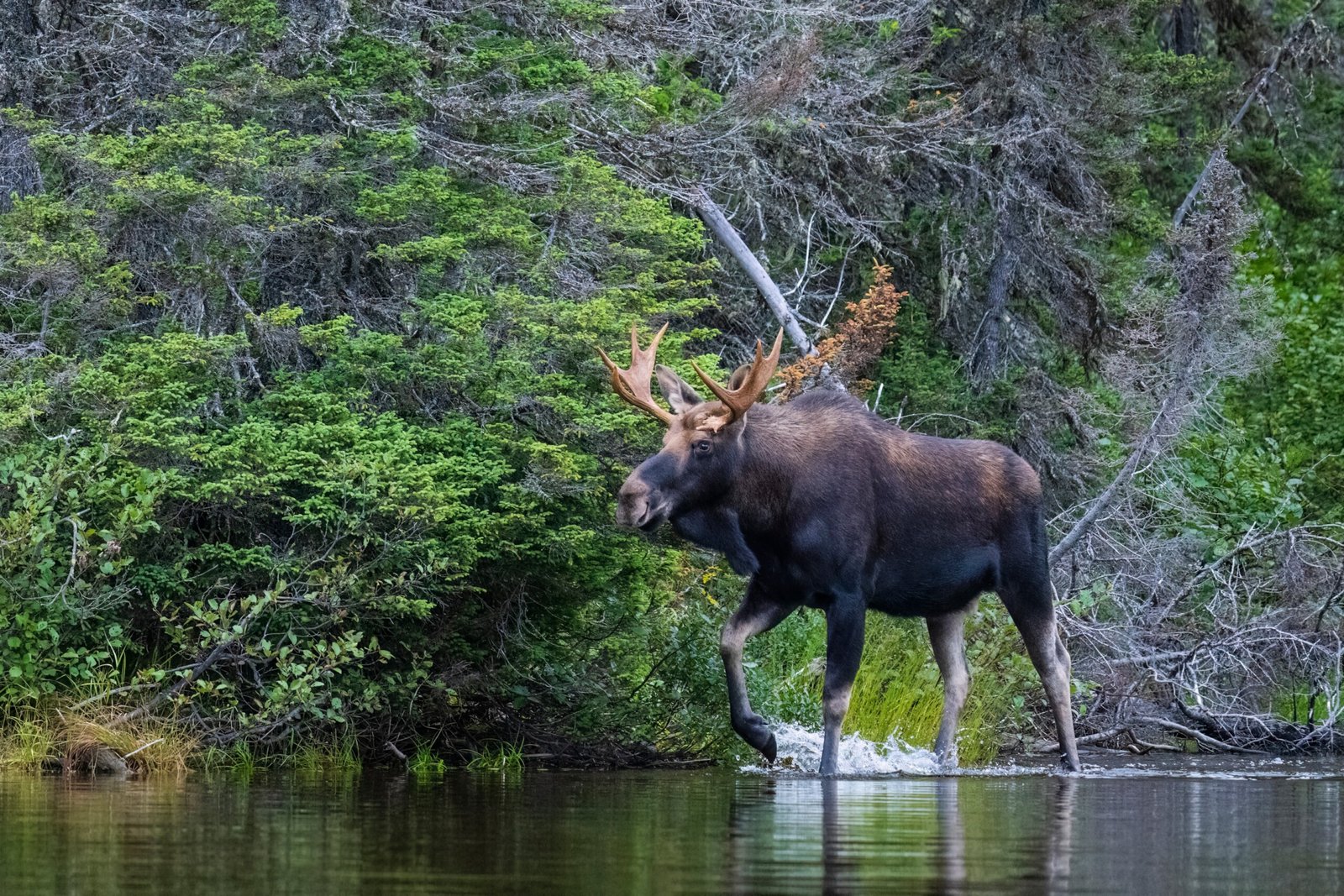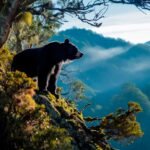Curious about spotting moose in British Columbia? This guide reveals the top locations, safety tips, and essential gear for moose watching in BC’s diverse landscapes. Dive in for expert advice and make your wildlife adventure unforgettable.
Key Takeaways
-
British Columbia is home to an estimated 115,000 to 192,000 moose, thriving in diverse habitats like wetlands and forests, which are crucial for their diet and survival.
-
Prime locations for moose spotting include Bowron Lake Provincial Park and Wells Gray Provincial Park, with the best viewing periods from late spring to early autumn.
-
Conservation efforts in British Columbia prioritize collaboration with First Nations and research initiatives, ensuring the health and sustainability of moose populations.
Moose in British Columbia: An Overview

British Columbia’s diverse landscape, ranging from wetlands and forests to meadows, provides an ideal habitat for moose to thrive. These gentle giants are herbivores, primarily feeding on aquatic plants, shrubs, and tree leaves, playing a crucial role in maintaining the balance of plant community structures. The province’s moose population is estimated to be between 115,000 and 192,000 individuals, influenced by habitat availability, hunting regulations, and predation.
Northern British Columbia, with its extensive forested and wetland areas, supports a significant moose population. These areas are essential for the survival of moose, providing ample food sources and safe habitats. Moose are not just a part of the wilderness; they are integral to the ecosystem, contributing to seed dispersal and serving as prey for predators like wolves and grizzly bears.
The health and numbers of moose populations in British Columbia are carefully monitored. Factors such as habitat changes, hunting pressures, and natural predation are continually assessed to ensure these animals thrive. Collaborative efforts, including those involving First Nations, play a vital role in the conservation and management of moose populations.
As you venture into the heart of British Columbia, you’ll find that moose are more than just a sight to behold. They are a testament to the rich biodiversity and natural beauty of the region. Understanding where and how to spot these majestic creatures will enhance your wildlife experience, making each encounter a memorable one.
Best Places to Spot Moose in British Columbia
British Columbia is dotted with numerous locations that offer prime opportunities for moose sightings. From provincial parks to the vast wilderness of northern regions, moose enthusiasts are spoiled for choice.
Bowron Lake Provincial Park, Wells Gray Provincial Park, and the expansive landscapes of Northern British Columbia stand out as some of the best places to observe these magnificent animals in their natural habitat.
Bowron Lake Canoe Circuit in Bowron Lake Provincial Park
Nestled in central British Columbia, Bowron Lake Provincial Park is a haven for wildlife lovers, particularly those eager to spot moose. The Bowron Lake Canoe Circuit, a world-renowned canoeing route, offers an unparalleled opportunity to witness moose in their natural surroundings. The best time to visit is from late spring to early fall, specifically from May 15 to the end of September, with peak sightings typically occurring in July and August. It is important to follow specific rules while navigating the park’s canoe circuit to ensure visitor safety and environmental protection.
As you paddle through the Bowron Lake Canoe Circuit, keep an eye out for moose along the Bowron River, a hotspot for these majestic creatures. The river’s serene environment and abundant vegetation make it an ideal feeding ground for moose, beavers, and martens. The Bowron Lake area, with its diverse habitats, provides a rich mosaic of wetlands, forests, and meadows where moose thrive. Babcock Lake, accessible through a short portage from Babcock Creek, is surrounded by forested hills and is part of a series of smaller lakes, adding to the scenic beauty of the circuit.
One of the highlights of the Bowron Lake Canoe Circuit is Isaac Lake, where moose are frequently spotted grazing along the shoreline. The tranquility of the lake and its surrounding wilderness offer perfect conditions for observing these animals from a respectful distance. Always remember to carry bear spray and maintain a safe distance to avoid disturbing the wildlife. Lanezi Lake, an integral part of the circuit, connects with the Cariboo River and offers opportunities for wildlife viewing, camping, and enjoying the stunning mountainous scenery.
Other notable spots within Bowron Lake Provincial Park include Sandy Lake, Unna Lake, and Spectacle Lake. These locations, with their picturesque landscapes and rich biodiversity, enhance the overall moose-watching experience. Whether you’re hiking, canoeing, or simply relaxing at a designated campsite, the chances of encountering a moose are high. Swan Lake, merging with Spectacle Lake, is a significant section of the circuit, offering recreational opportunities and unique geographical features.
The Bowron Lake Canoe Circuit is more than just a bowron lake canoe trip; it’s an immersive experience that brings you closer to nature. The thrill of spotting a moose in the wild, coupled with the park’s stunning scenery, makes Bowron Lake Provincial Park a must-visit destination for any wildlife enthusiast. The Bowron Lake Canoe Circuit offers a unique way to explore this beautiful area, including its scenic portage trails.
Wells Gray Provincial Park
Wells Gray Provincial Park, located in central British Columbia, is renowned for its breathtaking landscapes and rich biodiversity. This provincial park is another excellent location for observing moose in their natural habitat. The best times to visit are during the late spring and early autumn when moose are most active and visible as they roam to feed.
The park’s diverse terrain, featuring stunning waterfalls, dense forests, and open meadows, provides a perfect backdrop for moose sightings. Visitors can often spot these majestic animals grazing in the meadows or emerging from the forest to drink from the park’s numerous water bodies. For an optimal moose-watching experience, stay quiet, use binoculars for a closer look, and observe from a safe distance to minimize disturbances to the wildlife.
In addition to moose, Wells Gray Provincial Park is home to a variety of other wildlife, including grizzly bears, deer, and numerous bird species. The park’s well-maintained trails and park facilities make it accessible for visitors of all ages, ensuring a memorable and educational wildlife-watching experience.
Northern British Columbia
Northern British Columbia is a vast and vital region for moose, hosting significant populations that are crucial to local ecosystems. The area’s diverse habitats, ranging from dense forests to expansive wetlands, allow moose to thrive in various environmental conditions. Key locations for moose spotting include areas near rivers and lakes, where these animals frequently gather to feed.
One of the best strategies for spotting moose in northern BC is to venture out during dawn or dusk when they are most active. The early morning and late evening light provide excellent conditions for observing these animals as they graze or move through the landscape. Whether you’re exploring the side of the circuit near the Cariboo River or the southern shore of Bear Lake, the chances of encountering a moose are high.
The sheer beauty and remoteness of northern British Columbia make it a prime destination for wildlife enthusiasts. From the rugged mountain passes to the tranquil lakeshores, every corner of this region offers a unique opportunity to connect with nature and witness the majestic moose in their natural habitat.
Moose Behavior and Seasonal Patterns
Understanding moose behavior and seasonal patterns maximizes your chances of spotting these animals in the wild. Moose are primarily herbivores, consuming a varied diet that includes twigs, leaves, and aquatic plants. During the winter months, their diet may shift to include coniferous trees as other food sources become scarce.
Moose are known for their impressive swimming abilities, often diving underwater to feed on aquatic vegetation. Capable of swimming at speeds of up to 6 miles per hour, they are well-adapted to their wetland habitats. This behavior is particularly noticeable during the warmer months when moose seek out water bodies to cool off and find food.
Seasonal migration significantly influences moose behavior. In the summer, they may move to higher elevations to avoid the heat, while in winter, they descend to lower elevations in search of food. This migration pattern affects where and when you are likely to spot moose, with dawn and dusk being the optimal times for sightings.
Moose also adapt their behavior to their environment, seeking shelter in dense forests during harsh weather conditions. This adaptability ensures their survival across the varied landscapes of British Columbia, from the coastal regions to the interior forests.
Safety Tips for Moose Encounters
Encountering a moose in the wild is an exhilarating experience, but it’s crucial to prioritize safety. Maintaining a respectful distance is essential to avoid stressing the animals or disturbing their natural behavior. If a moose becomes aware of your presence, speak softly and back away slowly to avoid provoking it.
Cow moose with calves are particularly defensive and require extra caution. If you find yourself in a situation where a moose charges, it’s advisable to take cover behind a solid object or run away. Moose can be unpredictable, and their size and strength make them potentially dangerous if they feel threatened.
In the unfortunate event that you are knocked down by a moose, curl up into a ball, protect your head, and remain still until the moose loses interest and moves away. Additionally, carrying bear spray is a good practice, as it can be used to deter aggressive wildlife, including grizzly bears and moose.
Being prepared and respectful of moose and other wildlife ensures a safer and more enjoyable experience for everyone. Remember, these animals are a vital part of the ecosystem, and our actions can significantly impact their well-being.
Conservation Efforts for Moose in British Columbia
Conservation efforts for moose in British Columbia are multifaceted, involving collaboration with First Nations, researchers, and the public. Moose play a critical role in the ecosystem, aiding in seed dispersal and providing food for predators like wolves and grizzly bears. Various programs and initiatives have been implemented to ensure their survival.
The Provincial Moose Research Project, initiated in 2013, focuses on understanding how landscape changes affect cow moose survival. This project has recently expanded to include monitoring calf survival, providing comprehensive data on moose populations. Additionally, the Provincial Moose Winter Tick Survey assesses the impact of ticks on moose health, which is crucial for understanding their overall well-being.
Collaboration with First Nations is a cornerstone of moose conservation in British Columbia. Indigenous communities often engage in sustainable hunting practices, balancing cultural needs with conservation efforts. Educational programs tailored for Indigenous communities enhance traditional practices and promote moose health and management.
The BC Moose Tracker app is another innovative tool aiding in moose conservation. This mobile app allows hunters and the public to report moose sightings and hunting experiences, providing valuable data for monitoring populations across the province. Such citizen science initiatives are crucial for informed management decisions.
Collaborative wildlife health programs developed with First Nations focus on community-driven assessments and enhance knowledge about moose health. These efforts ensure that moose populations remain robust and resilient, contributing to the overall health of British Columbia’s ecosystems.
Moose-Watching Tours and Guides
For those looking to enhance their wildlife-watching experience, numerous moose-watching tours and guides are available in British Columbia. The Moose Valley Experience in Whistler offers guided scenic excursions where participants may encounter moose along with other wildlife. These tours explore diverse terrains, including old-growth forests and wetlands, providing a comprehensive wildlife-watching experience.
While moose sightings are possible on these tours, it’s important to remember that wildlife encounters cannot be guaranteed. Moose are wild animals, and their movements are unpredictable. However, experienced guides often know the best locations and times for sightings, increasing the likelihood of encountering these magnificent creatures.
In addition to the Moose Valley Experience, other tours and guides focus on different regions of British Columbia, offering varied experiences. Whether you’re paddling along the Bowron Lake Canoe Circuit or hiking through provincial parks, guided tours can provide valuable insights and enhance your understanding of the local wildlife.
Participating in a guided tour not only increases your chances of seeing moose but also ensures a safe and educational experience. Knowledgeable guides can share information about moose behavior, conservation efforts, and the cultural significance of these animals, enriching your wildlife-watching adventure.
Essential Gear for Moose Watching
Proper preparation is key to a successful moose-watching adventure. Wearing long-sleeved clothing and using bug spray can help protect against insect bites, which are common in moose habitats. A rain jacket is also essential for staying dry during unexpected weather changes, ensuring that you remain comfortable throughout your trip.
Sturdy footwear is necessary for navigating uneven terrain while searching for moose. Whether you’re hiking through dense forests or walking along riverbanks, good quality boots will provide the support and protection needed. Additionally, carrying a comfortable backpack helps in easily transporting essential gear during your excursions.
Carry bear spray, as it can be an effective deterrent not only for grizzly bears but also for moose if you find yourself in a dangerous situation. It’s important to familiarize yourself with how to use bear spray properly before heading out. Other useful items include binoculars for spotting moose from a distance and a camera with a telephoto lens for capturing detailed images.
For those planning to spend several days in the wilderness, camping gear such as tents, sleeping bags, and cooking equipment will be necessary. Ensure you have a reliable map of the area, like the BC Parks map, to navigate and locate designated campsites and other key locations. Being well-prepared with the right gear will enhance your moose-watching experience and ensure your safety and comfort.
Summary
Moose watching in British Columbia offers a unique and unforgettable experience for wildlife enthusiasts. From the serene waters of the Bowron Lake Canoe Circuit to the majestic landscapes of Wells Gray Provincial Park and the vast wilderness of northern BC, the opportunities to observe these magnificent creatures are plentiful. By understanding moose behavior, practicing safety, and being well-prepared with the right gear, you can ensure a successful and memorable adventure. Embrace the beauty of British Columbia’s wilderness, respect its wildlife, and cherish the moments spent in the presence of these majestic animals.
Frequently Asked Questions
What is the best time of year to spot moose in Bowron Lake Provincial Park?
The best time to spot moose in Bowron Lake Provincial Park is from late spring to early fall, particularly in July and August when sightings are most frequent.
What should I do if I encounter a moose while hiking?
If you encounter a moose while hiking, it is crucial to maintain a respectful distance and back away slowly while speaking softly. Should the moose charge, seek cover and protect your head if you fall.
What gear is essential for a moose-watching trip?
For a successful moose-watching trip, it is essential to equip yourself with long-sleeved clothing, a rain jacket, sturdy footwear, bug spray, bear spray, binoculars, and a camera with a telephoto lens. This gear will enhance your experience while ensuring your safety and comfort.
Are moose-watching tours available in British Columbia?
Yes, moose-watching tours are available in British Columbia, including options like the Moose Valley Experience in Whistler, offering guided excursions through varied terrains.
How do conservation efforts help protect moose in British Columbia?
Conservation efforts in British Columbia, such as the Provincial Moose Research Project and the Provincial Moose Winter Tick Survey, play a vital role in monitoring and managing moose populations, ensuring their protection through collaboration with First Nations and community engagement. Such initiatives are essential for the sustainability of moose in the region.


